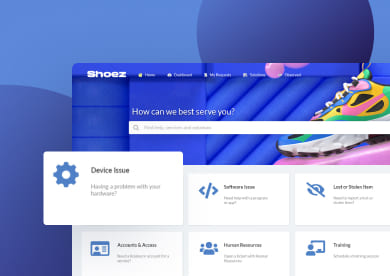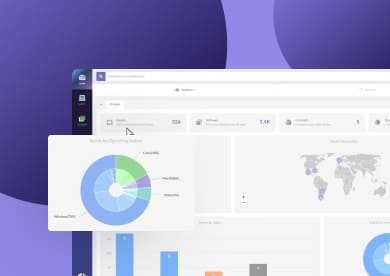IT Service Management often looks straightforward on paper. You define processes, choose the right tools, align with a framework like ITIL, and you’re off. But when it’s time to put all of it into practice, things get complicated fast. In our experience supporting ITSM implementations of all sizes, most organizations run into the same friction points; some expected, some not.
That’s why we’re outlining the eight most common ITSM challenges. More importantly, we’re showing how to work through them in ways that make sense for your team and your business — not just in theory!
Let’s go through them one by one.
8 Most Common ITSM Challenges And How to Overcome Them
Some of these challenges show up early in the process, while others surface once the system is already running. In both cases, they tend to reflect gaps between how the platform is used and how ITSM best practices are meant to work.
Recognizing these issues early on makes correcting the course easier before they become harder to fix.
1. Unclear roles and responsibilities
Even when processes are well-documented, it’s common to see teams get stuck over ownership issues. Tasks sit unattended because no one’s sure who’s responsible. Worse, multiple people might assume someone else is handling them.
This usually happens when roles are vaguely defined or when responsibilities shift but aren’t properly communicated. For example, incident escalations may stall if the service desk doesn’t know which tier 2 group should take over, or if there’s no clear RACI matrix for change approvals.
In one of our webinars, Business Relationship Manager Jyoti Chopra pointed out how a lack of open communication and weak relationships often lead to these breakdowns. If people avoid addressing tension or fail to share information transparently, the process won’t hold up. Teams must talk openly, work through conflicts, and maintain clear connections.
To avoid this, make sure every service, process, and task has a designated owner. Map out responsibilities clearly across functions, and revisit them when your organizational structure changes. A simple internal Service Desk SOP or an ownership tag within your ITSM tool can go a long way.
2. Poor request categorization and routing
If tickets land in the wrong queue, progress stalls. And if the service catalog is too broad, too technical, or poorly structured, end users won’t know where to submit their requests in the first place.
We’ve seen service desks where nearly everything arrives as a generic "IT issue" ticket. That means ticket triage takes longer, workloads get misbalanced, and metrics lose reliability.
A good starting point is simplifying the request forms and using conditional logic to guide the user through the right inputs. Combine that with automation rules that assign tickets based on category or keywords, and you’ll reduce manual effort while improving first-time routing.
3. Inconsistent use of the ITSM platform
Even if the organization has the right tool in place, it won’t work well if people use it inconsistently or bypass it altogether. One team might log problems in the platform, while another prefers side channels like Slack or email. That creates blind spots and makes reporting nearly useless.
ITSM tools only generate value when used as a central hub. That doesn’t mean enforcing strict rules with no flexibility, but it does require setting expectations and offering training.
Build usage habits gradually by integrating the platform into daily service workflows. Highlight how it benefits the user directly — whether that’s through faster response times, reduced context-switching, or clearer communication.

4. Weak Knowledge Management
Too many teams rely on tribal knowledge, even when a knowledge base is technically available. If documentation is outdated, hard to search, or not maintained by those doing the work, it gets ignored.
This challenge becomes more visible during onboarding, handoffs, or staff turnover. Valuable context disappears, and teams waste time rediscovering solutions that were already known.
Knowledge Management should be a living part of your ITSM process, not an afterthought. Encourage agents to document resolved issues immediately or schedule recurring time to review and update articles. Track which knowledge is being used and identify gaps based on repeated ticket topics.
"Knowledge should be a quick question and answer. Somebody asked the question; here is the answer. And it should be easy to consume. I understand that when you get into these more technical things, there are a lot of steps. But it should still be easy to consume.”
Liz Bunger, KCS Program Manager at Motive
Live session - Ticket Volume
5. Lack of alignment with the business
Service teams often focus on SLAs, ticket volumes, and resolution times. While those are valid indicators, they don’t always reflect what the business actually needs. For example, meeting SLA targets might look good on a dashboard but still leave end users frustrated if key issues aren’t prioritized correctly.
“There's a concept that we talk about called 'moments over time.’ And it's the fact that, especially as IT, we tend to take this transactional approach. "How was this incident?" ‘How was this request?’ ‘Did we hit our targets?’ And if you look across IT, ‘Did we hit our availability targets?’ So, we do this, and we're just very siloed, and we're not looking end-to-end at the overall experience, and that the way people feel is not about one transaction. It's based on multiple transactions, and they just start to have a feeling about it, or they're disgruntled, or, you know, they'll go around those processes, or go complain to somebody.“
Rae Ann Bruno,
Episode 14 of Ticket Volume
To stay aligned, bring business stakeholders into conversations about priority, service definitions, and success criteria. Don’t just report on performance — connect the dots to business impact. That might mean showing how downtime affected revenue or how automating a request cut wait times for onboarding.
6. Reactive Change Management
Change Management tends to get formalized late. We’ve seen this often: teams initially handle changes informally or retroactively. But as systems grow and more teams get involved, the risks multiply. One miscommunicated update can create a service outage that affects dozens of users.
To prevent this, Change Management should be introduced early and scaled up gradually. That doesn’t mean you need full CAB meetings from day one. Start with a simple process to review, document, and schedule changes in a shared system. Then, build from there, adding approval flows, impact assessments, or standard change templates as your environment evolves.
7. Poor incident / problem separation
Incident and Problem Management serve different purposes, but they’re often treated the same. As a result, temporary fixes get logged as solutions, and root causes never get addressed.
It’s easy to confuse the two when there’s pressure to resolve tickets quickly. But long-term stability depends on identifying patterns and addressing underlying causes. It’s self-evident that if the same incident occurs repeatedly, there’s likely a problem that needs analysis, not another workaround.
A good practice is to define a threshold for when a set of incidents should trigger problem investigation. Even a basic recurring incident report can reveal where deeper attention is needed.

8. Reporting that’s either too shallow or too complex
Reports often fall into two extremes: they’re either basic metrics with little insight, or they’re overbuilt dashboards no one actually reads. Both outcomes lead to the same result: decisions based on incomplete or misunderstood information.
It helps to ask first: “Who’s reading the report, and what do they need from it?” An agent might want queue size trends. A manager might care more about missed SLAs and backlog age. Executives usually want summaries with business context.
Build different report views for different audiences, and revisit them regularly. Tie reporting back to actions — what the numbers mean, and what they suggest should happen next.
In conclusion
ITSM implementations aren’t easy, even with good tools and frameworks in place. Most of the issues we’ve covered here don’t come from technical complexity, but from misalignment between people, processes, and priorities. The good news is that these challenges are fixable.
With clear ownership, consistent practices, and a focus on practical outcomes, IT Service Management can start delivering real value. Remember that ITSM is not about closing tickets but improving services.















